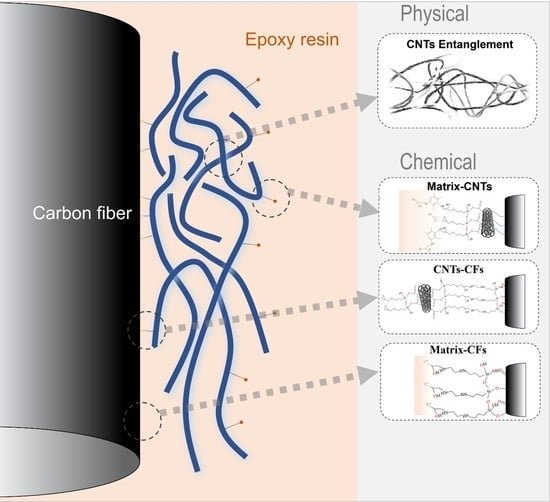Interfacial Enhancement by CNTs Grafting towards High-Performance Mechanical Properties of Carbon Fiber-Reinforced Epoxy Composites
Abstract
1. Introduction
2. Experimental Methods
2.1. Materials
2.2. Preparation of CNTs/CF Multi-Scale Reinforced Composites
2.3. Material Characterization
3. Results and Discussion
3.1. Characteristics of Modified CNTs
3.1.1. Surface Morphology Analysis
3.1.2. Surface Chemical Analysis
3.2. Characteristics of Modified CF Surfaces
3.2.1. Surface Morphology Analysis
3.2.2. Surface Chemical Analysis
3.2.3. Mechanical Properties of Composites
4. Conclusions
Supplementary Materials
Author Contributions
Funding
Data Availability Statement
Acknowledgments
Conflicts of Interest
References
- Yu, J.; Meng, L.; Fan, D.; Zhang, C.; Yu, F.; Huang, Y. The oxidation of carbon fibers through K2S2O8/AgNO3 system that preserves fiber tensile strength. Compos. Part B Eng. 2014, 60, 261–267. [Google Scholar] [CrossRef]
- Zhu, W.; Zhang, X.; Yin, Y.; Qin, Y.; Zhang, J.; Wang, Q. In-situ electrochemical activation of carbon fiber paper for the highly efficient electroreduction of concentrated nitric acid. Electrochim. Acta 2018, 291, 328–334. [Google Scholar] [CrossRef]
- Xie, Z.-Y.; Jin, G.-Y.; Zhang, M.; Su, Z.-A.; Zhang, M.-Y.; Chen, J.-X.; Huang, Q.-Z. Improved properties of carbon fiber paper as electrode for fuel cell by coating pyrocarbon via CVD method. Trans. Nonferr. Met. Soc. China 2010, 20, 1412–1417. [Google Scholar] [CrossRef]
- Chen, S.; Cao, Y.; Feng, J. Polydopamine as an efficient and robust platform to functionalize carbon fiber for high-performance polymer composites. ACS Appl. Mater. Interfaces 2014, 6, 349–356. [Google Scholar] [CrossRef]
- Davis, D.C.; Wilkerson, J.W.; Zhu, J.; Hadjiev, V.G. A strategy for improving mechanical properties of a fiber reinforced epoxy composite using functionalized carbon nanotubes. Compos. Sci. Technol. 2011, 71, 1089–1097. [Google Scholar] [CrossRef]
- Ma, W.; Zhao, Y.; Li, Y.; Zhang, P.; Cao, Z.; Yang, H.; Liu, C.; Tao, G.; Gong, F.; Matsuyama, H. Synthesis of hydrophilic carbon nanotubes by grafting poly(methyl methacrylate) via click reaction and its effect on poly(vinylidene fluoride)-carbon nanotube composite membrane properties. Appl. Surf. Sci. 2018, 435, 79–90. [Google Scholar] [CrossRef]
- Gao, B.; Zhang, R.; Wang, C. Enhanced mechanical properties of carbon fiber composites by grafting different structural poly(amido amine) onto fiber surface. Polym. Test. 2016, 56, 192–199. [Google Scholar] [CrossRef]
- Zhou, J.; Yuan, M.; Li, Z.; Meng, H.; Zhang, T.; Qi, L. A great improvement of tensile properties of C f/AZ91D composite through grafting CNTs onto the surface of the carbon fibers. Mater. Sci. Eng. A 2019, 762, 138061. [Google Scholar] [CrossRef]
- Moosburger-Will, J.; Bauer, M.; Schubert, F.; Kunzmann, C.; Lachner, E.; Zeininger, H.; Maleika, M.; Hönisch, B.; Küpfer, J.; Zschoerper, N.; et al. Methyltrimethoxysilane plasma polymerization coating of carbon fiber surfaces. Surf. Coat. Technol. 2017, 311, 223–230. [Google Scholar] [CrossRef]
- Shariatnia, S.; Kumar, A.V.; Kaynan, O.; Asadi, A. Hybrid Cellulose Nanocrystal-Bonded Carbon Nanotubes/Carbon Fiber Polymer Composites for Structural Applications. ACS Appl. Nano Mater. 2020, 3, 5421–5436. [Google Scholar] [CrossRef]
- Chen, Q.; Zhao, Y.; Zhou, Z.; Rahman, A.; Wu, X.F.; Wu, W.; Xu, T.; Fong, H. Fabrication and mechanical properties of hybrid multi-scale epoxy composites reinforced with conventional carbon fiber fabrics surface-attached with electrospun carbon nanofiber mats. Compos. Part B Eng. 2013, 44, 1–7. [Google Scholar] [CrossRef]
- Song, X.; Gao, J.; Zheng, N.; Zhou, H.; Mai, Y.-W. Interlaminar toughening in carbon fiber/epoxy composites interleaved with CNT-decorated polycaprolactone nanofibers. Compos. Commun. 2021, 24, 100622. [Google Scholar] [CrossRef]
- Li, Y.; Li, Y.; Ding, Y.; Peng, Q.; Wang, C.; Wang, R.; Sritharan, T.; He, X.; Du, S. Tuning the interfacial property of hierarchical composites by changing the grafting density of carbon nanotube using 1,3-propodiamine. Compos. Sci. Technol. 2013, 85, 36–42. [Google Scholar] [CrossRef]
- Zheng, N.; He, J.; Zhao, D.; Huang, Y.; Gao, J.; Mai, Y.-W. Improvement of atomic oxygen erosion resistance of carbon fiber and carbon fiber/epoxy composite interface with a silane coupling agent. Mater. Des. 2016, 109, 171–178. [Google Scholar] [CrossRef]
- Hu, W.; Sun, Z.; Yang, L.; Hu, C.; Zhang, S.; Wang, F.; Yang, B.; Cang, Y. Interfacial Strengthening and Self-Monitoring in Carbon Fiber-Reinforced Composites via Carbon Nanotube-Based Damage Sensors. Nanomaterials 2022, 12, 3717. [Google Scholar] [CrossRef]
- Yang, L.; Han, P.; Gu, Z. Grafting of a novel hyperbranched polymer onto carbon fiber for interfacial enhancement of carbon fiber reinforced epoxy composites. Mater. Des. 2021, 200, 109456. [Google Scholar] [CrossRef]
- Ji, F.; Liu, C.; Hu, Y.; Xu, S.; He, Y.; Zhou, J.; Zhang, Y. Chemically Grafting Carbon Nanotubes onto Carbon Fibers for Enhancing Interfacial Properties of Fiber Metal Laminate. Materials 2020, 13, 3813. [Google Scholar] [CrossRef]
- Zhou, S.; Wang, M.; Yang, Z.; Zhang, X. Polydopamine-Modified Nanochannels in Vertically Aligned Carbon Nanotube Arrays for Controllable Molecule Transport. ACS Appl. Nano Mater. 2019, 2, 3271–3279. [Google Scholar] [CrossRef]
- Yan, M.; Jiao, W.; Li, J.; Huang, Y.; Chu, Z.; Chen, X.; Shen, F.; Wang, Y.; Wang, R.; He, X. Enhancement of the cryogenic-interfacial-strength of carbon fiber composites by chemical grafting of graphene oxide/attapulgite on T300. Polym. Compos. 2020, 41, 5072–5081. [Google Scholar] [CrossRef]
- Yuan, X.; Zhu, B.; Cai, X.; Qiao, K.; Zhao, S.; Zhang, M.; Yu, J. Micro-configuration controlled interfacial adhesion by grafting graphene oxide onto carbon fibers. Compos. Part A Appl. Sci. Manuf. 2018, 111, 83–93. [Google Scholar] [CrossRef]
- Zhang, R.L.; Gao, B.; Ma, Q.H.; Zhang, J.; Cui, H.Z.; Liu, L. Directly grafting graphene oxide onto carbon fiber and the effect on the mechanical properties of carbon fiber composites. Mater. Des. 2016, 93, 364–369. [Google Scholar] [CrossRef]
- Zeng, L.; Tao, W.; Zhao, J.; Li, Y.; Li, R. Mechanical performance of a CFRP composite reinforced via gelatin-CNTs: A study on fiber interfacial enhancement and matrix enhancement. Nanotechnol. Rev. 2022, 11, 625–636. [Google Scholar] [CrossRef]
- Zhang, T.; Cheng, Q.; Xu, Z.; Jiang, B.; Wang, C.; Huang, Y. Improved interfacial property of carbon fiber composites with carbon nanotube and graphene oxide as multi-scale synergetic reinforcements. Compos. Part A Appl. Sci. Manuf. 2019, 125, 105573. [Google Scholar] [CrossRef]
- Fu, J.; Zhang, M.; Liu, L.; Xiao, L.; Li, M.; Ao, Y. Layer-by-Layer electrostatic self-assembly silica/graphene oxide onto carbon fiber surface for enhance interfacial strength of epoxy composites. Mater. Lett. 2019, 236, 69–72. [Google Scholar] [CrossRef]
- Zhang, W.; Deng, X.; Sui, G.; Yang, X. Improving interfacial and mechanical properties of carbon nanotube-sized carbon fiber/epoxy composites. Carbon 2019, 145, 629–639. [Google Scholar] [CrossRef]
- Ud Din, I.; Medhin, Y.; Aslam, N.; Bathusha, M.S.; Umer, R.; Khan, K.A. Rate dependent piezoresistive characterization of smart aerospace sandwich structures embedded with reduced graphene oxide (rGO) coated fabric sensors. Compos. Commun. 2022, 36, 101382. [Google Scholar] [CrossRef]
- Donchak, V.; Stetsyshyn, Y.; Bratychak, M.; Broza, G.; Harhay, K.; Stepina, N.; Kostenko, M.; Voronov, S. Nanoarchitectonics at surfaces using multifunctional initiators of surface-initiated radical polymerization for fabrication of the nanocomposites. Appl. Surf. Sci. Adv. 2021, 5, 100104. [Google Scholar] [CrossRef]
- Baskaran, D.; Mays, J.W.; Bratcher, M.S. Polymer-Grafted Multiwalled Carbon Nanotubes through Surface-Initiated Polymerization. Angew. Chem. Int. Ed. 2003, 43, 2138–2142. [Google Scholar] [CrossRef]
- Xu, N.; Li, Y.; Zheng, T.; Xiao, L.; Liu, Y.; Chen, S.; Zhang, D. A mussel-inspired strategy for CNT/carbon fiber reinforced epoxy composite by hierarchical surface modification. Colloids Surf. A Physicochem. Eng. Asp. 2022, 635, 128085. [Google Scholar] [CrossRef]
- Mta, B.; Gspm, A.; Ms, B. Generalized shear lag theory for an elastic stress transfer between matrix and fibres having a variable radius. Int. J. Solids Struct. 2022, 239–240, 111464. [Google Scholar]
- Xie, J.Z.; Hein, S.; Wang, K.; Liao, K.; Goh, K.L. Influence of hydroxyapatite crystallization temperature and concentration on stress transfer in wet-spun nanohydroxyapatite-chitosan composite fibres. Biomed. Mater. 2008, 3, 025014. [Google Scholar] [CrossRef]
- Ng, X.W.; Hukins, D.W.L.; Goh, K.L. Influence of fibre taper on the work of fibre pull-out in short fibre composite fracture. J. Mater. Sci. 2010, 45, 1086–1090. [Google Scholar] [CrossRef]
- Xiong, S.; Zhao, Y.; Wang, Y.; Song, J.; Zhao, X.; Li, S. Enhanced interfacial properties of carbon fiber/epoxy composites by coating carbon nanotubes onto carbon fiber surface by one-step dipping method. Appl. Surf. Sci. 2021, 546, 149135. [Google Scholar] [CrossRef]
- Wu, G.; Ma, L.; Jiang, H.; Liu, L.; Huang, Y. Improving the interfacial strength of silicone resin composites by chemically grafting silica nanoparticles on carbon fiber. Compos. Sci. Technol. 2017, 153, 160–167. [Google Scholar] [CrossRef]
- Yu, M. Strength and Breaking Mechanism of Multiwalled Carbon Nanotubes Under Tensile Load. Science 2000, 287, 637–640. [Google Scholar] [CrossRef]
- Huq, A.; Goh, K.L.; Zhou, Z.R.; Liao, K. On defect interactions in axially loaded single-walled carbon nanotubes. J. Appl. Phys. 2008, 103, 054306. [Google Scholar] [CrossRef]



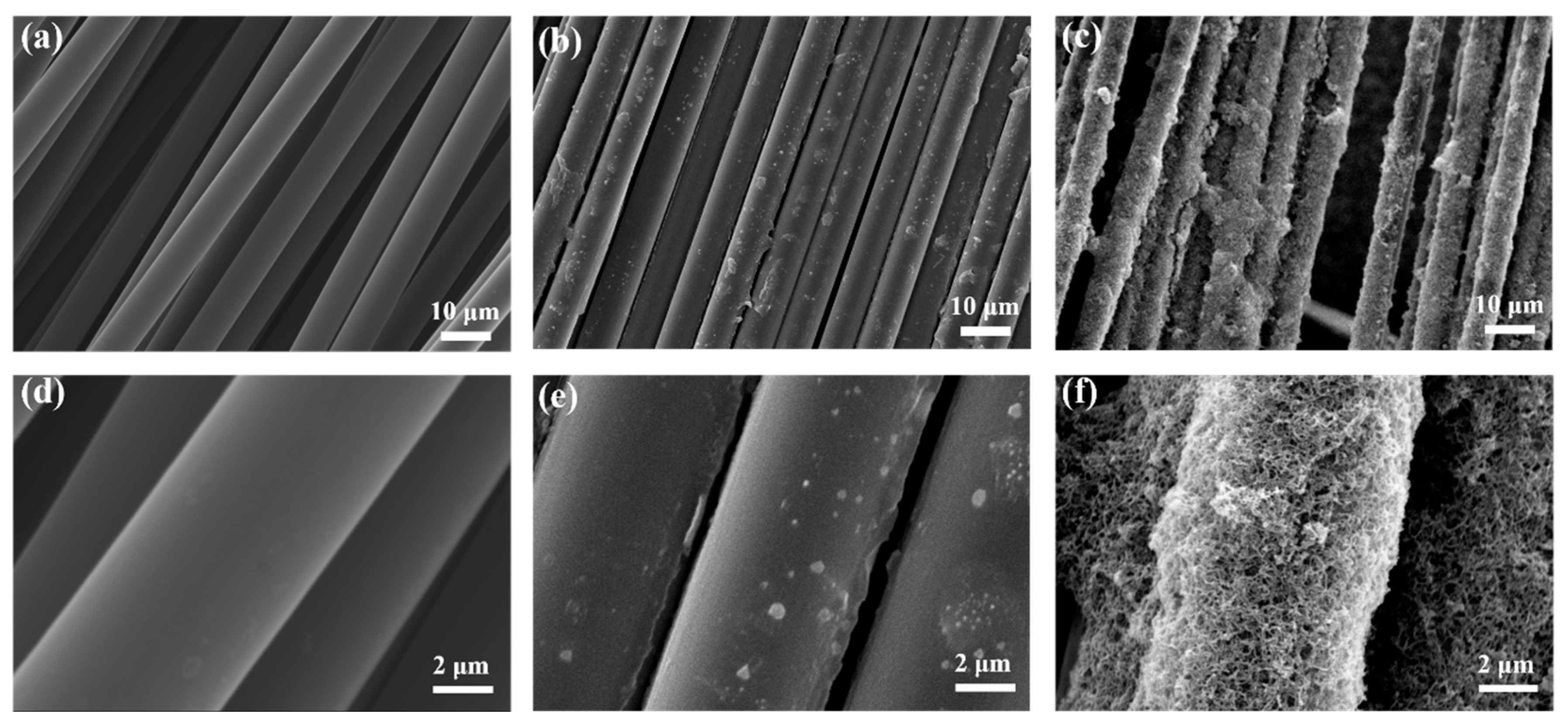

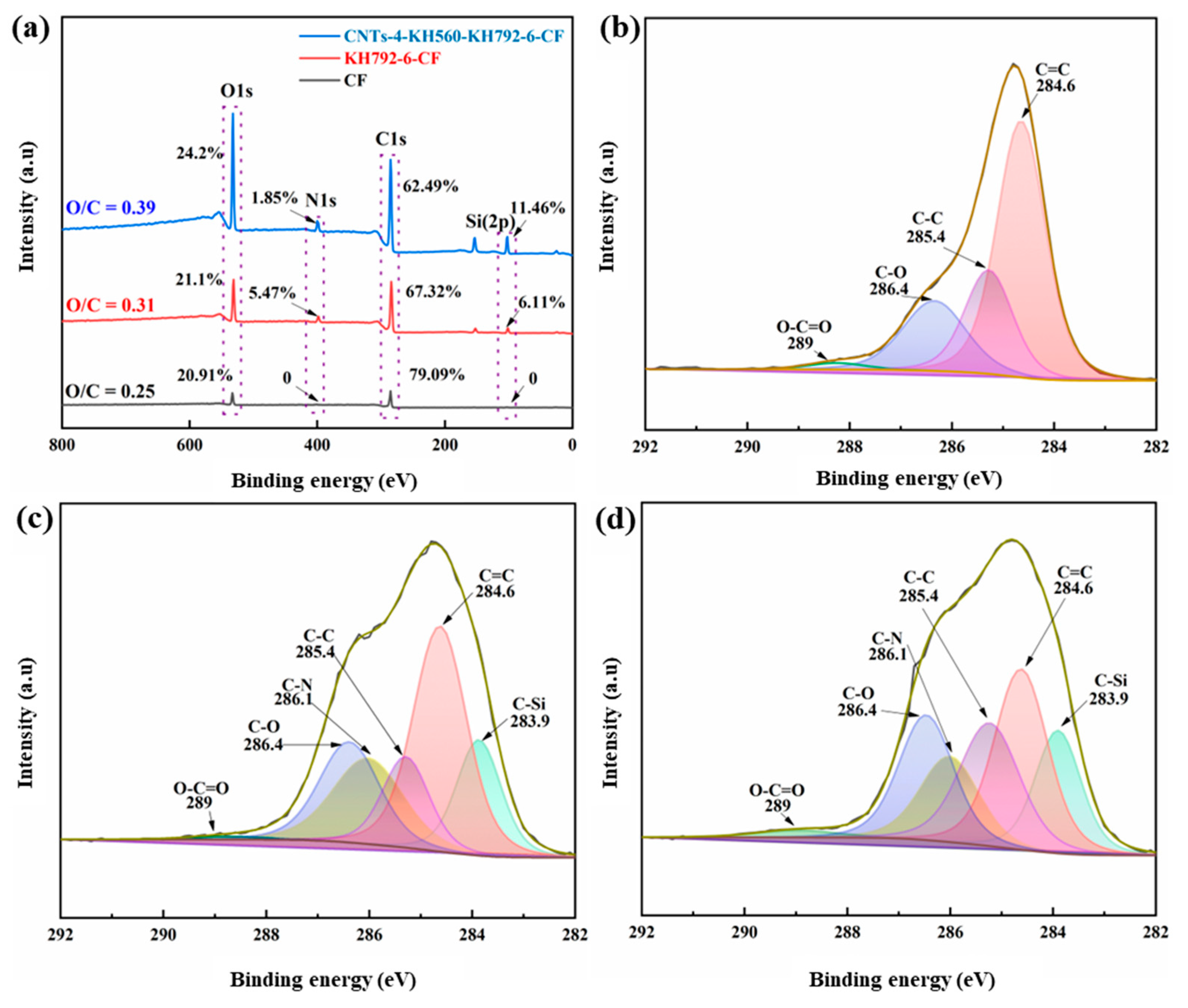
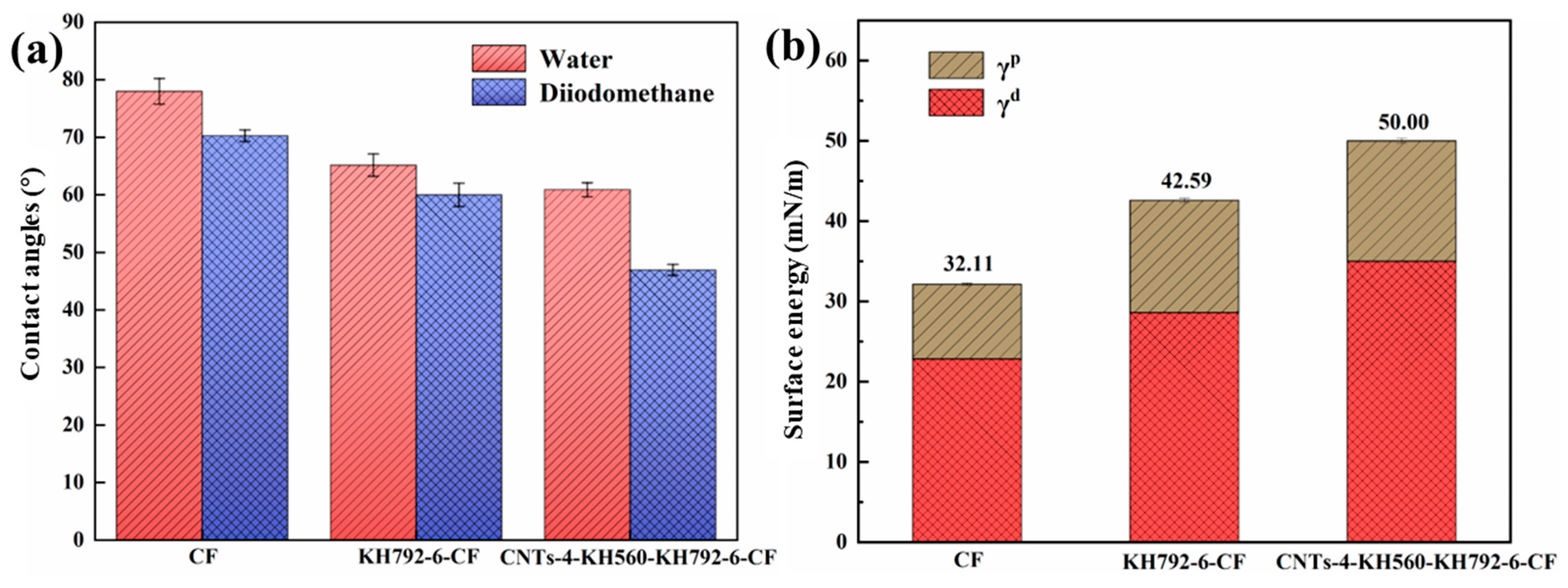
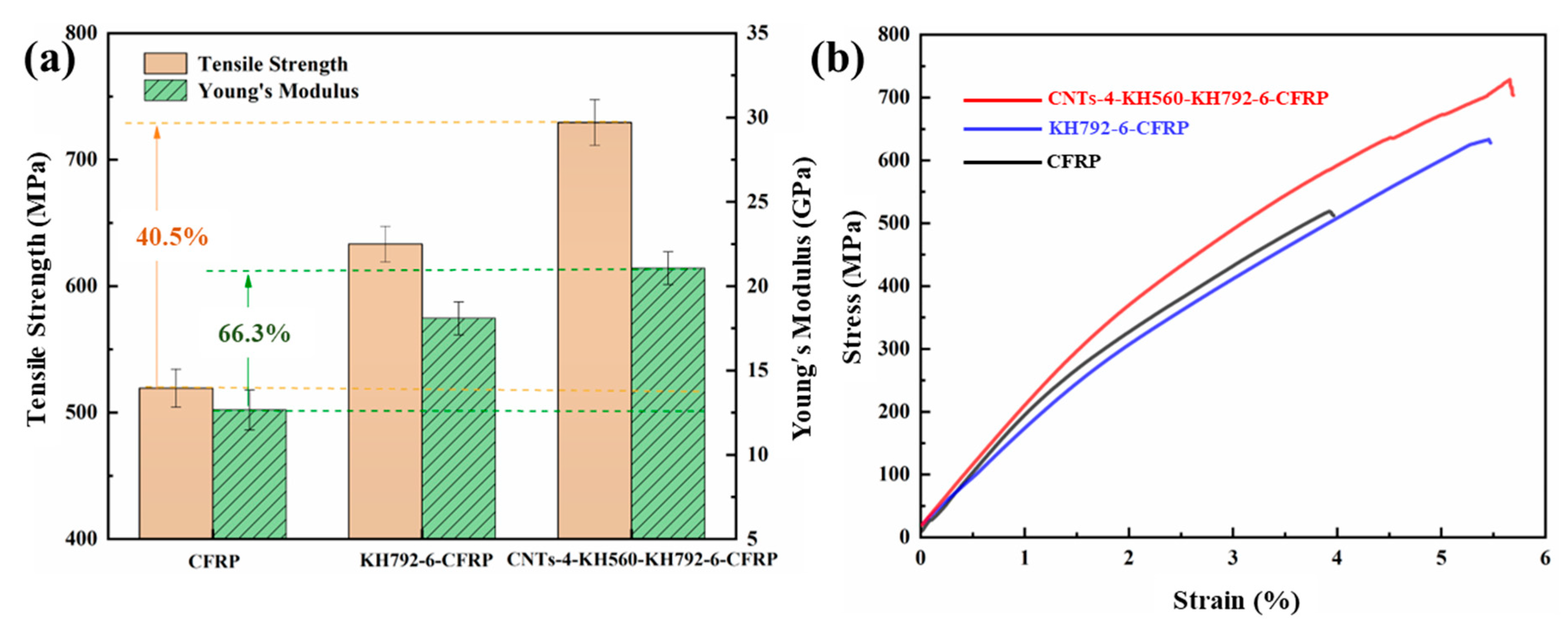
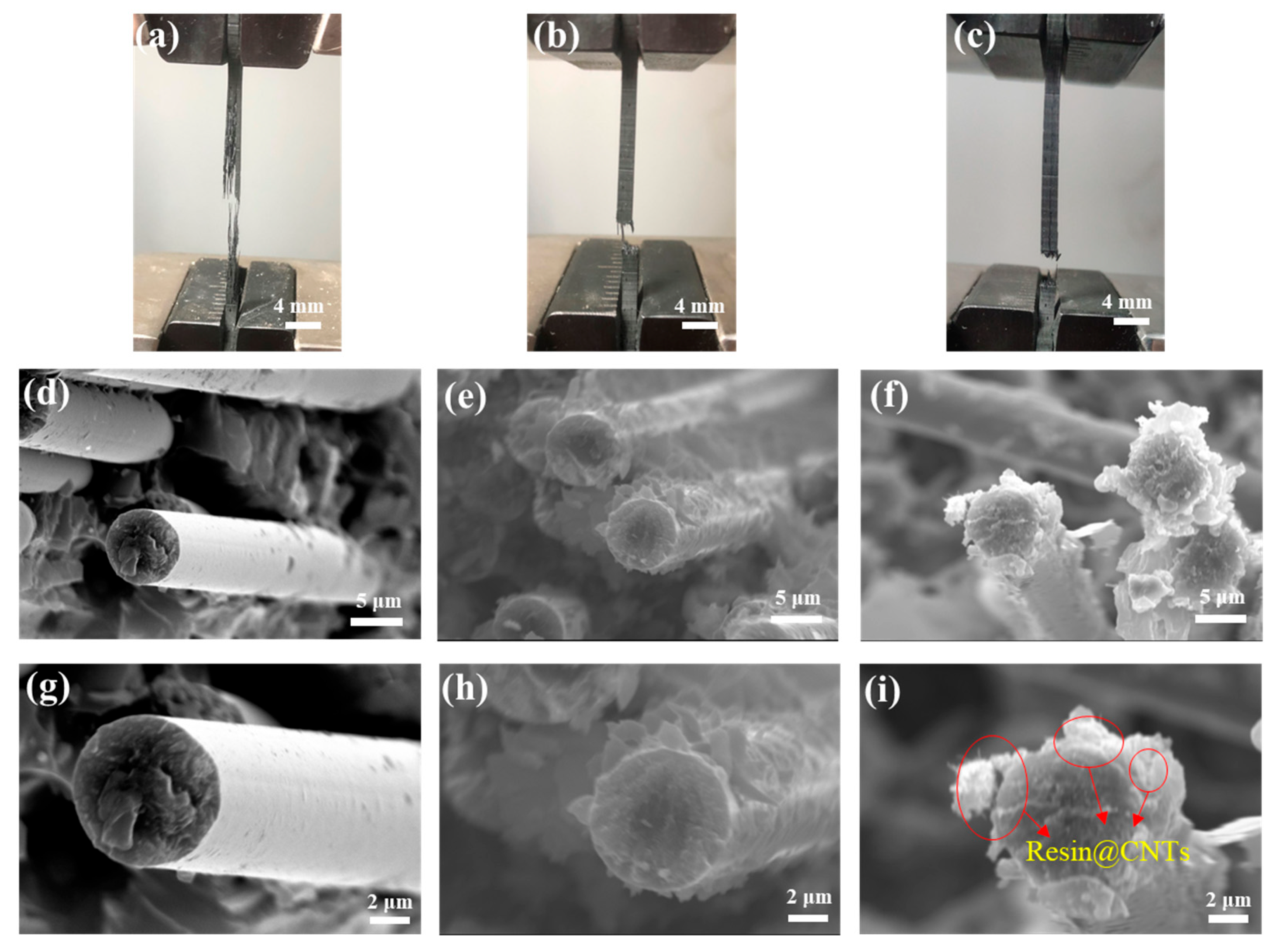
Disclaimer/Publisher’s Note: The statements, opinions and data contained in all publications are solely those of the individual author(s) and contributor(s) and not of MDPI and/or the editor(s). MDPI and/or the editor(s) disclaim responsibility for any injury to people or property resulting from any ideas, methods, instructions or products referred to in the content. |
© 2023 by the authors. Licensee MDPI, Basel, Switzerland. This article is an open access article distributed under the terms and conditions of the Creative Commons Attribution (CC BY) license (https://creativecommons.org/licenses/by/4.0/).
Share and Cite
Zhang, W.; Dai, M.; Liang, X.; Wang, X.; Wei, W.; Zhou, Z. Interfacial Enhancement by CNTs Grafting towards High-Performance Mechanical Properties of Carbon Fiber-Reinforced Epoxy Composites. Materials 2023, 16, 3825. https://doi.org/10.3390/ma16103825
Zhang W, Dai M, Liang X, Wang X, Wei W, Zhou Z. Interfacial Enhancement by CNTs Grafting towards High-Performance Mechanical Properties of Carbon Fiber-Reinforced Epoxy Composites. Materials. 2023; 16(10):3825. https://doi.org/10.3390/ma16103825
Chicago/Turabian StyleZhang, Wei, Mingfeng Dai, Xin Liang, Xi Wang, Wei Wei, and Zuowan Zhou. 2023. "Interfacial Enhancement by CNTs Grafting towards High-Performance Mechanical Properties of Carbon Fiber-Reinforced Epoxy Composites" Materials 16, no. 10: 3825. https://doi.org/10.3390/ma16103825
APA StyleZhang, W., Dai, M., Liang, X., Wang, X., Wei, W., & Zhou, Z. (2023). Interfacial Enhancement by CNTs Grafting towards High-Performance Mechanical Properties of Carbon Fiber-Reinforced Epoxy Composites. Materials, 16(10), 3825. https://doi.org/10.3390/ma16103825





